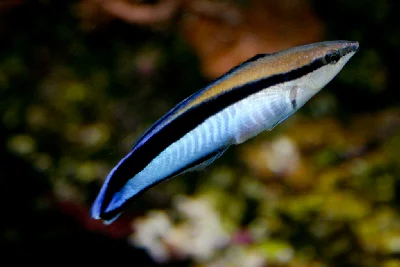Bluestreak Cleaner Wrasse
Labroides dimidiatus
The Bluestreak Cleaner Wrasse (Labroides dimidiatus), commonly referred to as the Common Cleanerfish, is a notable species among the cleaner wrasses inhabiting coral reefs from Eastern Africa and the 🌊 Red Sea to 🇵🇫 French Polynesia. Engaging in a mutualistic relationship, this species consumes parasites and dead tissue from the skin of larger fish, benefiting from a food supply and protection, while offering significant health advantages to its hosts. The species has also garnered attention for potentially passing the mirror test; however, this claim remains subject to debate.
This species is characterized by its small size, typically reaching an average length of 10 cm (3.9 inches), with a maximum length of 14 cm (5.5 inches). Distinctive features include a prominent longitudinal black stripe extending from its eyes to the tail, complemented by a white (occasionally slightly yellowish) back and stomach that transitions to bright blue at the front. In juveniles, the coloration consists of a striking electric blue line against a black background.
Genetic analyses of L. dimidiatus indicate two monophyletic clades within its population. 🌊 Indian Ocean populations are generally distinguished by varying stripe widths compared to their western Pacific counterparts. Interestingly, 🇯🇵 Japanese cleaner wrasses, despite visual distinctions, share a closer genetic relationship with 🌊 Indian Ocean populations, and both clades exhibit overlap around Papua 🇵🇬 New Guinea. The discovery also suggests potential polyphyly, with species Labroides pectoralis and Labroides bicolor being nested within the L. dimidiatus clade, indicating that the Bluestreak Cleaner Wrasse may encompass multiple species.
This species is predominantly located on coral reefs across the tropics, spanning from the 🌊 Red Sea and 🌊 Indian Ocean to the western Pacific, including regions like Papua 🇵🇬 New Guinea, 🇯🇵 Japan, 🇫🇯 Fiji, and 🇵🇫 French Polynesia. Notably, it was first recorded in the Kermadec Islands Marine Reserve north of 🇳🇿 New Zealand in 2015 through the analysis of extensive documentary film footage.
Cleaner wrasses are typically associated with cleaning stations, which are managed by various groups of wrasses such as juveniles, adult pairs, or a group of females led by a dominant male. These wrasses exhibit a distinctive dance-like motion to welcome incoming larger fish, known as "clients," to the cleaning station. The Bluestreak Cleaner Wrasse's function is to remove ectoparasites from these clients, which it does by virtue of its identifiable lateral stripe and characteristic movements. Clients, recognizing these signals, adopt specific postures to facilitate the wrasse's access to their bodies. Other fish species, such as those within the genus Elacatinus, also engage in this cleaning behavior. The Bluestreak Cleaner Wrasse notably provides services to a variety of aquatic species including those within the families Balaenopteridae, Chondrichthyes, Homaridae, Octopodidae, and Dermochelyidae.
Certain fish species mimic the cleaner wrasse's behavior, such as Aspidontus taeniatus, which instead inflicts minor damage by tearing skin or flesh. Similarly, the Bluestreak Fangblenny (Plagiotremus rhinorhynchos) imitates juvenile cleaner wrasses to exploit the concentration of potential prey within these stations.
Moreover, the Bluestreak Cleaner Wrasse exhibits regional variations in its dependence on ectoparasites as a food source. For instance, in environments such as the Great Barrier Reef, it acts as a facultative cleaner, feeding primarily on corals. Juvenile cleaners in some regions have been observed to bite their clients more often than adults, altering the dynamics of their mutualistic interactions. Contrarily, in areas where these wrasses rely exclusively on client parasites, fish with access to cleaning services generally exhibit better body condition. Studies from Marsa Bareika in the Ras Mohamed Nature Reserve, 🇪🇬 Egypt, show that these wrasses reduce the need for active immunity among client fish, as evidenced by lower antibody responses compared to those without cleaner access.
In terms of social behavior, males of the species are territorial, maintaining dominance over females within their territories. In the absence of a dominant male, a larger female may undergo sex change to assume control of the territory.
Comments
Please, sign in to leave comment
No Comments yet
Last Update: May 28, 2025

